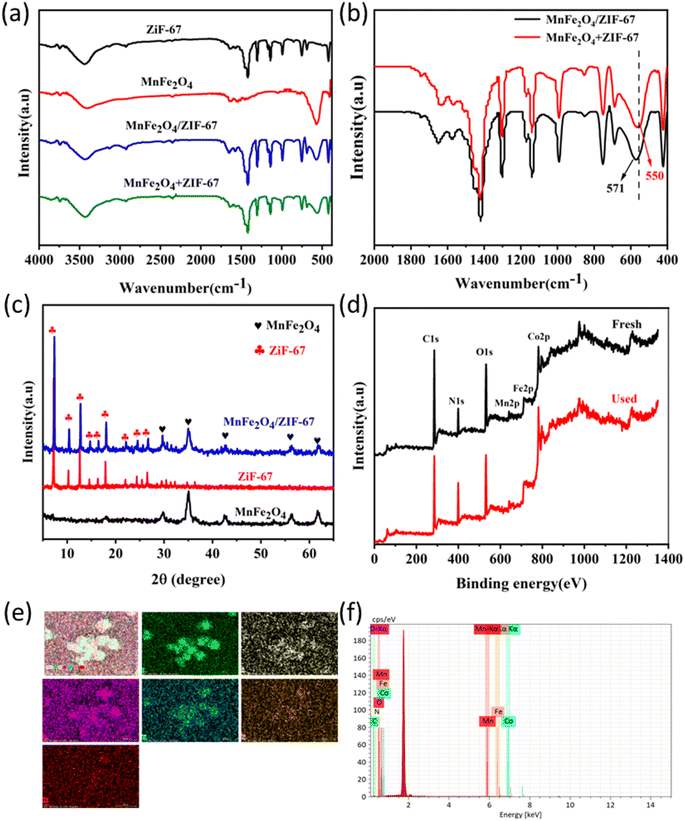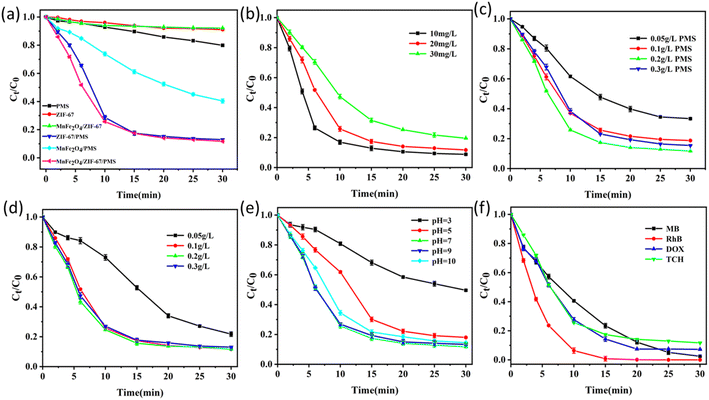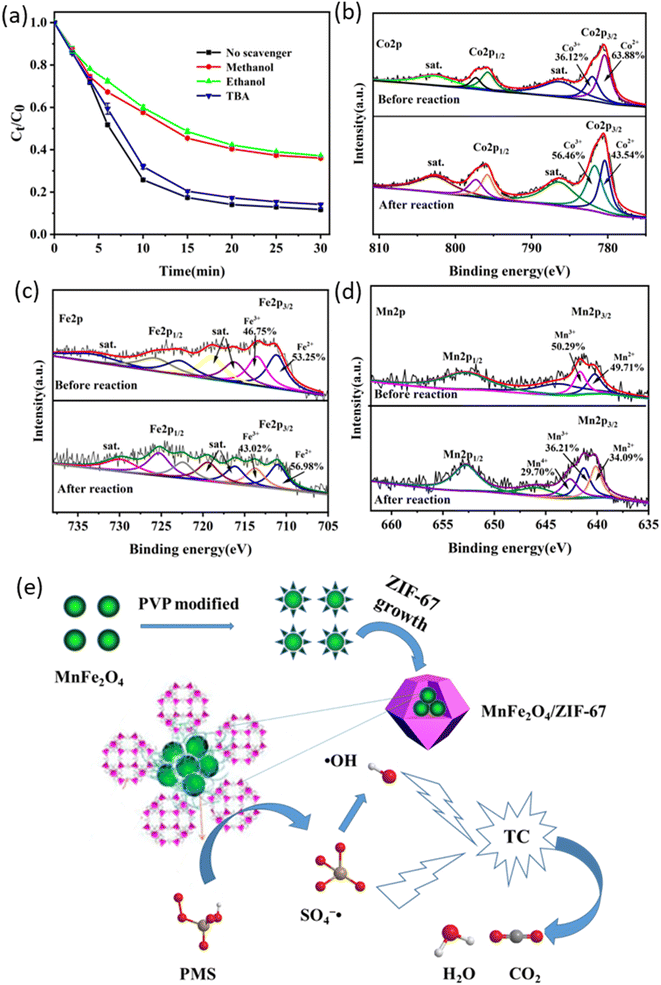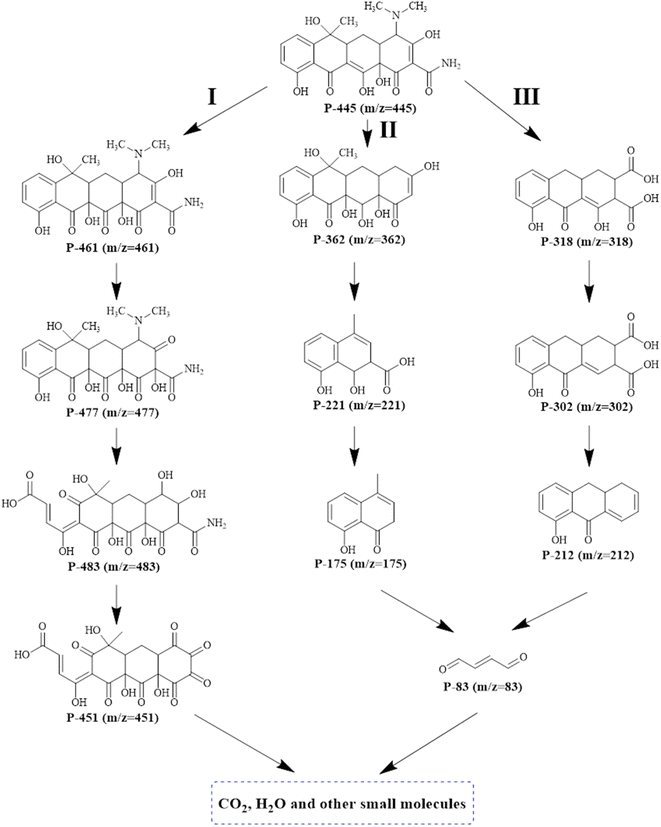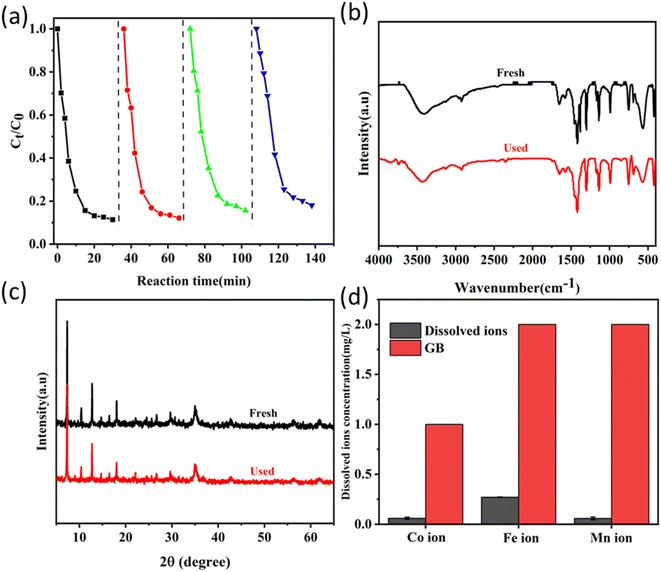 Open Access Article
Open Access ArticleMagnetic MnFe2O4/ZIF-67 nanocomposites with high activation of peroxymonosulfate for the degradation of tetracycline hydrochloride in wastewater
Si Lu ,
Sasha You
,
Sasha You ,
Junhao Hu
,
Junhao Hu ,
Xiang Li and
Ling Li
,
Xiang Li and
Ling Li *
*
Ministry-of-Education Key Laboratory for the Synthesis and Application of Organic Function Molecules, Hubei University, 430062, People's Republic of China. E-mail: lingli@hubu.edu.cn
First published on 4th March 2024
Abstract
Advanced oxidation processes (AOPs) based on PMS have been used to degrade various refractory pollutants such as drugs, endocrine disruptors, dyes and perfluorinated compounds due to their wide application range, mild reaction conditions, fast reaction rate and simple operation. In this study, tetracycline hydrochloride (TCH) was degraded based on this method. Magnetic MnFe2O4/ZIF-67 nanocomposites were successfully prepared by a hydrothermal method, which combined the magnetic separation characteristics of MnFe2O4 with the high catalytic activity of ZIF-67 and were used to activate peroxymonosulfate (PMS) to efficiently degrade TCH. Satisfactory removal results were obtained with this simple and readily available material, with 82.6% of TCH removed in 15 min. The effect of different conditions on the degradation effect was investigated, and the optimal catalyst concentration and PMS concentration were determined to be 0.1 g L−1 and 0.2 g L−1, respectively, and all had good degradation effects at pH 5 to 10. XPS, impedance test and radical quenching experiments were used to investigate the degradation mechanism. The results showed that sulfate radical (SO4−˙) was the main active species in the degradation process. In addition, the catalyst has good cyclic stability, which provides a new idea for the removal of TCH in wastewater. It is worth mentioning that the catalyst also has good degradation property for other pollutants.
1 Introduction
In recent decades, with the continuous development of the social economy and the rapid improvement of production capacity, the ensuing environmental problems have become increasingly serious.1,2 Water environmental pollution has attracted more and more attention.3 Tetracycline hydrochloride (TCH) is a representative broad-spectrum antibiotic, widely used in clinical therapy, aquaculture, animal husbandry, and other fields.4–7 Overuse of TCH causes it to accumulate in large quantities in wastewater, posing a serious threat to the ecosystems and human health.8,9 Due to its stable chemical structure and antibacterial properties, it is difficult to biodegrade, so it is urgently required to find more effective ways to degrade TCH in wastewater.10,11Researchers have found a variety of methods to remove TCH, including adsorption,12 membrane separation,13 biodegradation,14 and advanced oxidation processes.15,49 Compared with other methods, AOPs have the advantages of simple operation, fast and efficient response and environmental friendliness, and have attracted more and more attention.16–19 Common oxidants of AOPs include peroxymonosulfate (PMS), peroxydisulfate (PDS), and hydrogen peroxide (H2O2). Because PMS is more easily activated than PDS,20 and compared with ˙OH produced by H2O2, SO4−˙ produced by PMS has the advantages of long life, good selectivity, and wide working pH range;21–24 as such, the type of AOPs based on PMS activation to generate active radicals has received wide attention.50,51 Many transition metal ions (such as Co2+, Fe3+, Cu2+, and Mn2+) can effectively activate PMS to produce active free radicals, among which cobalt ions have been reported to have the best ability to activate PMS.25–29 However, although the Co2+/PMS system can degrade organic pollutants, it has the problem that homogeneous catalysts cannot be recovered, and carcinogenic Co2+ will have an impact on human health,30 so it is particularly important to find cobalt-containing heterogeneous catalysts.
Metal–organic frameworks (MOFs) exhibit excellent performance in wastewater treatment due to their unique structure such as high specific surface area and large porosity.31–37 ZIF-67, a mature cobalt-based MOF, has high thermal and chemical stability, which shows certain advantages in wastewater treatment.46–48 For example, the microporous ZIF-67 synthesized by Liang et al. showed ultra-high adsorption capacity for the antibiotic CIP and successfully removed CIP.38 Another example is the synthesis of ZIF-67 by Dong et al., which successfully achieved rapid degradation of carbamazepine in wastewater with a catalytic efficiency of eight times that of MnO2.39 However, although ZIF-67, the cobalt-containing multiphase catalyst, has a high catalytic efficiency, its difficulty in separating from wastewater limits its application.
Magnetic separation technology has become one of the most promising separation technologies due to its advantages of low cost and high efficiency. The magnetic MOF matrix composite material can comprehensively utilize the high porosity and high catalytic efficiency of MOFs and the magnetic separation characteristics of magnetic materials40 so that the materials can be separated and recovered by external magnetic force while removing antibiotics from water. For magnetic materials, spinel ferrites XFe2O4 (X = Mn, Fe, Co, Ni, and Cu) have attracted great attention due to their significant nanometer size, high specific surface area, and superparamagnetic behavior.41 One of the most impressive is the ferromanganite (MnFe2O4), which can not only achieve catalytic effects through the synergistic effect of Fe and Mn but also magnetic separation and recovery through its inherent magnetism.42 However, the inherent magnetism of MnFe2O4 makes it easy to agglomerate, thus reducing its specific surface area and affecting the catalytic activity.43 In addition, it is easy to cause excessive leaching of Mn2+/Fe3+ resulting in secondary pollution, so it is a good choice to use some carriers to fix MnFe2O4.
Based on the above discussion, we combined MnFe2O4 and ZIF-67 to retain the high catalytic activity of Co-based MOFs ZIF-67; moreover magnetic separation and recovery could be carried out. Using PMS as an oxidant, the degradation of TCH in water by MnFe2O4/ZIF-67-activated PMS was investigated. The advantage of MnFe2O4/ZIF-67 material is that the material is simple and easy to obtain, requires only a short time to achieve efficient degradation, and can be reused by magnetic recycling.
2 Experimental
2.1 Chemicals and materials
Iron chloride hexahydrate (FeCl3·6H2O), manganese chloride hexahydrate (MnCl3·6H2O), cobalt nitrate hexahydrate (Co(NO3)2·6H2O), 2-methylimidazole (2-MIM), and tetracycline hydrochloride (TCH) were purchased from Macklin, China. Peroxymonosulfate (PMS) was obtained from Aladdin, China, and methanol (MeOH) was purchased from Shanghai Sinopharm Chemical Reagent Co., Ltd. All the reagents were used without further purification.2.2 Synthesis of magnetic MnFe2O4
FeCl3·6H2O and MnCl3·6H2O were dispersed in a beaker containing ethylene glycol at a molar ratio of 2![[thin space (1/6-em)]](https://www.rsc.org/images/entities/char_2009.gif) :
:![[thin space (1/6-em)]](https://www.rsc.org/images/entities/char_2009.gif) 1 and ultrasonically dissolved to obtain a transparent mixed solution. Then, the pre-prepared NaOH solution was gradually added to the above-mixed solution, and the pH value of the solution was monitored with a pH meter until the black slurry with pH > 10 was obtained. After stirring for 30 min, the slurry was transferred to a Teflon-lined autoclave at 200 °C for 24 h to obtain MnFe2O4.
1 and ultrasonically dissolved to obtain a transparent mixed solution. Then, the pre-prepared NaOH solution was gradually added to the above-mixed solution, and the pH value of the solution was monitored with a pH meter until the black slurry with pH > 10 was obtained. After stirring for 30 min, the slurry was transferred to a Teflon-lined autoclave at 200 °C for 24 h to obtain MnFe2O4.
2.3 Synthesis of magnetic composite MnFe2O4/ZIF-67
Solution A was formed by mixing 0.1 g MnFe2O4 and PVP with 30 mL methanol under ultrasound for 30 min. At the same time, 1.16 g of Co(NO3)2·6H2O and 1.31 g of 2-methylimidazole were dissolved in 15 mL of methanol each at room temperature under ultrasound to form solution B and solution C, respectively,. Then, solution C was slowly added to solution A for ultrasonic mixing for 5 min, and solution B was added dropwise to the above dispersion. After 20 min of ultrasound, the mixture was transferred to a Teflon-lined autoclave at 120 °C for 6 h. Finally, the precipitate was collected using magnets, washed with methanol several times, and dried at 70 °C for 12 h.2.4 Characterization
The surface morphology was observed by a JSM6510LV tungsten lamp scanning electron microscope (SEM, JEOL, Japan). The X-ray diffraction pattern of the sample was obtained using a D8-advanced X-ray diffractometer (XRD, Bruker, Germany) equipped with a Cu Kα source (40 mA, 40 kV). Fourier transform infrared spectroscopy (FTIR) in the region of 400–4000 cm−1 was measured on a single-frequency infrared spectrometer using the potassium bromide tablet technique. The oxidation states of Co, Fe and Mn in MnFe2O4/ZIF-67 were studied by X-ray photoelectron spectroscopy (XPS, Thermo, USA). The ultraviolet-visible spectrophotometer (752N, INESA, Shanghai) was used to measure the corresponding absorbance of the pollutant at 357 nm.2.5 Degradation experiment
All experiments were conducted in a 100 mL beaker placed on a magnetic stirrer at room temperature. To avoid the effect of natural light on degradation, the beaker was wrapped in tin foil for dark treatment. Moreover, to evaluate the performance of the catalyst for activating PMS to degrade TCH, a certain amount of MnFe2O4/ZIF-67 was dispersed in a beaker containing 50 mL TCH solution, and appropriate PMS was immediately added to initiate the oxidation reaction. Then, within the specified time, an appropriate amount of the reaction solution was collected and quenched with 0.5 mL methanol to stop further reaction. The absorbance of the quenched solution at 357 nm was measured using a UV-vis spectrophotometer, and the residual TCH concentration was calculated according to the standard curve. In addition, all the optimization experiments, other conditions and steps were kept unchanged, and only the PMS concentration, catalytic concentration and initial pH value (adjusted by NaOH and HCl) were changed.3 Results and discussion
3.1 Characterization
FT-IR spectra of MnFe2O4, ZIF-67 and MnFe2O4/ZIF-67 are shown in Fig. 1a. FT-IR spectrum of the MnFe2O4/ZIF-67 composite was basically similar to that of ZIF-67, except that the absorption peak at 571 cm−1 was attributed to the Fe–O–Fe group in the MnFe2O4 particle, which indicated the successful doping of MnFe2O4. The absorption peak at 422 cm−1 was attributed to the Co–N stretching vibrations of ZIF-67. The peaks at 1055 and 1390 cm−1 correspond to the presence of the benzene ring. The peaks at 1350–1500 cm−1 can be attributed to the stretching vibration of the imidazole ring, and the peaks at 900–1350 cm−1 can be attributed to the plane vibration of the imidazole ring. In addition, as shown in Fig. 1b, the peak position of MnFe2O4/ZIF-67 at 571 cm−1 is greatly shifted from that observed in the physical mixture of MnFe2O4 + ZIF-67. Therefore, it can be inferred that MnFe2O4/ZIF-67 is not a simple physical mixing. Instead, a new composite material was synthesized.Fig. 1c shows the XRD patterns of MnFe2O4/ZIF-67, MnFe2O4 and ZIF-67 for a comparison. The diffraction peaks of MnFe2O4/ZIF-67 composites at 2θ = 30.2°, 35.7°, 43.3°, 57.2° and 62.8° were consistent with those of MnFe2O4 nanoparticles. Moreover, the diffraction peaks at 2θ = 7.4°, 10.4°, 12.8° and 18.0° correspond to the (011), (002), (112) and (222) Bragg planes of pure ZIF-67 crystals, respectively. This clearly confirms the successful preparation of the MnFe2O4/ZIF-67 composite, in which the inherent crystal structure of ZIF-67 is not significantly disturbed by the introduction of MnFe2O4 nanoparticles.
Fig. 1d shows the full XPS spectrum of MnFe2O4/ZIF-67 before and after the reaction, from which it can be seen that there are Co, Fe, Mn, C, N and O elements in MnFe2O4/ZIF-67, which further confirmed the successful synthesis of the composite material. Fig. 1e shows the element mapping of MnFe2O4/ZIF-67, in which C, N, O, Co, Fe and Mn also existed, which was also proven by EDS analysis of MnFe2O4/ZIF-67, as shown in Fig. 1f. They are consistent with the results of the full XPS spectrum, and also proved the successful synthesis of MnFe2O4/ZIF-67.
The structure and surface morphology of MnFe2O4/ZIF-67, MnFe2O4 and ZIF-67 were characterized by scanning electron microscopy and transmission electron microscopy. The SEM image of Fig. 2a shows that MnFe2O4 particles were small-sized nanoparticles, which were agglomerated because of their small particle size and strong magnetic interactions. It can be observed from Fig. 2b that the prepared ZIF-67 showed uniform rhombohedral dodecahedral crystal shapes with particle sizes between 500 and 600 nm, which was consistent with the literature reports.44 Fig. 2c and d show that the surface of MnFe2O4/ZIF-67 was relatively rough compared to the morphology of ZIF-67, which may be due to the fact that MnFe2O4 was successfully compounded with ZIF-67. TEM images shown in Fig. 2e and f also clearly show the morphology of MnFe2O4/ZIF-67, and it was also found that MnFe2O4 and ZIF-67 were successfully compounded, and the size of ZIF-67 was consistent with the results of SEM images.
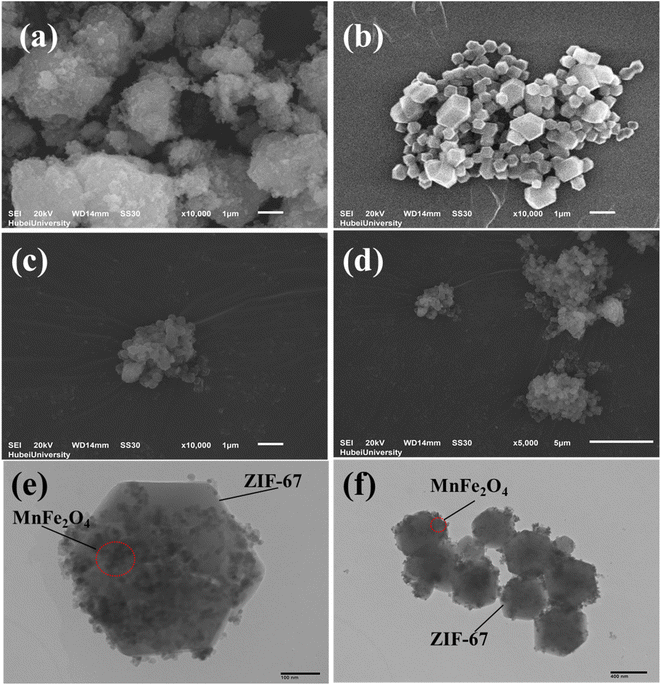 | ||
| Fig. 2 SEM images of (a) MnFe2O4, (b) ZIF-67, and (c and d) MnFe2O4/ZIF-67. (e and f) TEM images of MnFe2O4/ZIF-67. | ||
To explore the reasons for the rapid degradation efficiency of MnFe2O4/ZIF-67, impedance tests were conducted on MnFe2O4/ZIF-67, MnFe2O4 and ZIF-67 and the results are shown in Fig. 3a. It is clearly observed that MnFe2O4/ZIF-67 showed a smaller semicircle in the high frequency region than ZIF-67 and MnFe2O4, indicating an accelerated electron transfer rate.45 Both Fe and Mn in the active metal center of MnFe2O4/ZIF-67 can promote the surface electron transfer rate and improve the degradation efficiency.
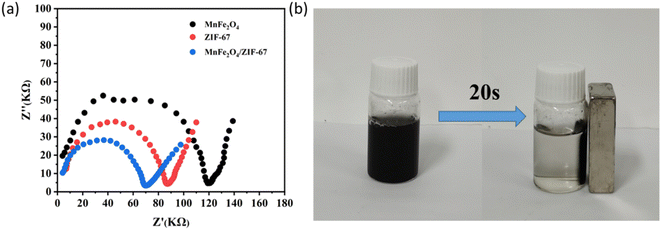 | ||
| Fig. 3 (a) EIS plots of MnFe2O4, ZIF-67 and MnFe2O4/ZIF-67. (b) Magnetic recovery of MnFe2O4/ZIF-67. | ||
The magnetic recovery ability of the catalyst was investigated by external magnetic force, as shown in Fig. 3b, and it was found that the MnFe2O4/ZIF-67 catalyst could be easily separated by a magnet within 20 s.
3.2 Catalytic performance
The removal effects of different catalysts on TCH were evaluated. The experimental conditions were 0.1 g per L catalyst, 0.2 g per L PMS and 20 mg per L TCH, and the pH value of the solution was 7.0. As shown in Fig. 4a, the TCH removal rate of pure ZIF-67 and MnFe2O4/ZIF-67 groups were 8.9% and 7.9%, within 30 min, respectively, indicating that the adsorption effect of materials on TCH was negligible. When no catalyst was added, only 20% of TCH was degraded in the presence of PMS alone. When both MnFe2O4 and PMS were added, the degradation efficiency of TCH was about 60% within 30 min. In addition, it can be observed that using the same dose of ZIF-67 and MnFe2O4/ZIF-67 to catalyze PMS, the degradation effect was almost similar at 87.2% and 88.3%, within 30 min, respectively. However, we were surprised to find that the degradation rate of TCH in the MnFe2O4/ZIF-67/PMS system was faster. In the first 6 min, the TCH removal rate using ZIF-67/PMS system was 34.3%, while the TCH removal rate using MnFe2O4/ZIF-67/PMS increased to 48.2%. It showed that MnFe2O4/ZIF-67/PMS could achieve rapid degradation in a short time. This phenomenon can be attributed to the fact that the introduction of MnFe2O4 can provide synergistic interaction between the two active metals and the cobalt in ZIF-67, thus promoting degradation. In addition, in the MnFe2O4/ZIF-67/PMS system, the removal rate of TCH can reach 82.6% in only 15 min, indicating the rapid degradation effect of the material.The effects of different conditions (initial TCH concentration, initial pH, PMS dose and catalytic dose) on TCH degradation were investigated. It can be seen from Fig. 4b that the degradation effect is greatly enhanced when the TCH concentration is reduced from 30 to 10 mg L−1. This phenomenon can be attributed to the high concentration of pollutant molecules competing for the strong oxidizing free radicals produced by PMS activation. In addition, it has been reported that the intermediates generated by the side reaction consume part of the sulfate radical and hydroxyl radical, which also reduces the degradation rate of TCH.
Using PMS as the oxidant in this experiment, the effects of different amounts of PMS on TCH degradation were investigated, and the results are shown in Fig. 4c. When the concentration of PMS increased in the range of 0.05–0.2 g L−1, the removal efficiency of TCH increased from 66.6% to 88.3% within 30 min. However, when the concentration of PMS continued to increase, the removal efficiency of TCH was significantly reduced. The improvement of TCH degradation efficiency and the rate are mainly due to the production of more active components. However, when the concentration of PMS continued to increase to 0.3 g L−1, the removal efficiency of TCH decreased, which may be caused by the self-quenching of excess PMS. Therefore, 0.2 g per L PMS was selected for further experimental exploration.
The effects of different doses of MnFe2O4/ZIF-67 on TCH removal were investigated to determine the optimal dosage of the catalyst, as shown in Fig. 4d. The figure shows that when the amount of the catalyst is less than 0.1 g L−1, only 50% of the TCH was degraded within 15 min, this is because active sites provided by a small amount of the catalyst were not rich, which affect the degradation effect. When the amount of the catalyst continued to exceed 0.1 g L−1, the TCH degradation rate remained basically unchanged for 30 min. The possible reason for this phenomenon is that more catalysts will be clustered together and occupy part of the active sites. Therefore, 0.1 g per L MnFe2O4/ZIF-67 was selected for the catalytic degradation experiment.
The stability of PMS and the formation of free radicals were affected by different pH values of the solution. Therefore, the effects of different initial pH values (3–10) on TCH degradation efficiency in the MnFe2O4/ZIF-67/PMS system were studied. As can be seen from Fig. 4e, when the initial pH of the solution is neutral, the degradation of TCH in the MnFe2O4/ZIF-67/PMS system is as high as 88%. When it drops to 3, less than 50% of the TCH is removed. The unsatisfactory TCH degradation efficiency under super acidic conditions may be due to the fact that HSO5− is decomposed into sulfate instead of activating into a sulfate radical in the presence of excess hydrogen ions. Under the condition of peralkaline pH = 10, the degradation efficiency of TCH is about 85%, which is lower than the removal rate under neutral conditions. There may be two reasons for this phenomenon: first, PMS may self-decompose instead of generating sulfate radical, the specific process is shown in eqn (1) and (2). Second, under alkaline conditions, the active metal tends to produce hydroxide, resulting in the reduction of the active site.
| HSO5− + SO52− → HSO6− + SO42− | (1) |
| HSO6− + OH− → H2O + SO42− + O2 | (2) |
Finally, the suitability of the catalyst for other contaminants was also evaluated. DOX, RhB, MB and TCH were selected as pollutant models for the catalytic degradation experiments. It can be observed from Fig. 4f that the removal rate of the four pollutants reached more than 88% within 30 min, indicating that the degradation effect is good enough, and it also indicated the wide applicability of MnFe2O4/ZIF-67.
3.3 Degradation mechanism and pathway consideration
The ROS in the reaction solution was determined using a free radical quenching test to predict the reaction mechanism. Fig. 5a shows the effect of common scavengers such as methanol (MeOH), tert-butanol (TBA) and ethanol (EtOH) on TCH degradation in MnFe2O4/ZIF-67/PMS systems. Compared with the degradation amount without a quenching agent, the amount degraded after adding 100 mM of tert-butanol decreased slightly. After adding 100 mM of EtOH and MeOH, TCH dropped substantially with a degradation efficiency of only 65%. These results indicate that SO4−˙ and ˙OH are the main active species in MnFe2O4/ZIF-67/PMS, but the former plays a dominant role.To study the catalytic mechanism, the surface metal valence of the MnFe2O4/ZIF-67 catalyst was characterized by XPS spectroscopy. As shown in Fig. 5b, for pre-reaction Co, the peaks at 780.4 eV (Co 2p3/2) and 795.7 eV (Co 2p1/2) correspond to Co2+, and the peaks at 782.0 eV (Co 2p3/2) and 797.3 eV (Co 2p1/2) correspond to Co3+. The contents of Co2+ and Co3+ were 63.88% and 36.12%, respectively. For the Co after the reaction, the peak positions did not significantly shift. The peaks at 780.4 eV (Co 2p3/2) and 795.8 eV (Co 2p1/2) correspond to Co2+, and the peaks at 781.7 eV (Co 2p3/2) and 797.3 eV (Co 2p1/2) correspond to Co3+. The contents of Co2+ and Co3+ were 43.54% and 56.46%, respectively. The decrease of Co2+ content and the increase of Co3+ content after the reaction indicate that Co2+ was converted to Co3+ during the reaction. Fig. 5c shows the change of Fe valence content on the catalyst surface before and after the reaction. Before the reaction, the two main peaks of Fe 2p3/2 at 710.5 eV and 712.6 eV correspond to Fe2+ and Fe3+, respectively. After the reaction, the peak area changed but there was no obvious peak shift. The two main peaks of Fe 2p3/2 at 710.3 eV and 712.8 eV correspond to Fe2+ and Fe3+, respectively. The relative content of Fe2+ increased from 53.25% to 56.98%, and the relative content of Fe3+ decreased from 46.75% to 43.02%. As can be seen from Fig. 5d, the two main peaks of Mn 2p3/2 at 640.2 eV and 641.7 eV correspond to Mn2+ and Mn3+, respectively, and no significant Mn4+ was detected, and the contents of Mn2+ and Mn3+ were 49.71% and 50.29%, respectively. The three main peaks of Mn 2p3/2 at 640.2, 641.3 and 642.6 eV correspond to Mn2+, Mn3+ and Mn4+, respectively, and the contents of Mn2+, Mn3+ and Mn4+ were 34.09%, 36.21% and 29.70%, respectively. After the reaction, Mn4+ appeared and the contents of Mn3+ and Mn2+ decreased, indicating that Mn changed from a low valence state to a high valence state during the reaction. These results indicate that there were redox reactions of Co3+/Co2+, Fe3+/Fe2+ and Mn2+/Mn3+/Mn4+ in the MnFe2O4/ZIF-67/PMS system.
Based on the above results, the TCH degradation mechanism of the MnFe2O4/ZIF-67/PMS system can be briefly summarized as follows:
| HSO5− + Co2+ → SO4−˙ + Co3+ + OH− | (3) |
| HSO5− + Fe2+ → SO4−˙ + Fe3+ + OH− | (4) |
| HSO5− + Mn2+ → SO4−˙ + Mn3+ + OH− | (5) |
| HSO5− + Mn3+ → SO4−˙ + Mn4+ + OH− | (6) |
| Fe2+ + Mn3+ → Fe3+ + Mn2+ | (7) |
| Fe3+ + Mn3+ → Fe2+ + Mn4+ | (8) |
| HSO5− + Co3+ → SO5−˙ + H+ + Co2+ | (9) |
| HSO5− + Fe3+ → SO5−˙ + H+ + Fe2+ | (10) |
| HSO5− + Mn3+ → SO5−˙ + H+ + Mn2+ | (11) |
| HSO5− + Mn4+ → SO5−˙ + H+ + Mn3+ | (12) |
| SO4−˙ + H2O → SO42− + ˙OH + H+ | (13) |
| 2SO5−˙ + 2OH− → 2SO42− + 2˙OH + 2O2 | (14) |
| SO4−˙/˙OH + TCH → intermediate product → H2O + CO2 | (15) |
First, HSO5− attacks the highly active metal reaction site provided by MnFe2O4/ZIF-67 to produce SO4−˙ (see eqn (3)–(8)), which is a similar process to the generation of hydroxyl radicals in the Fenton reaction. The excess HSO5− reacts with the high-valence metal center on the surface of MnFe2O4/ZIF-67 to form SO5−˙ (see eqn (9)–(12)), thus contributing to the cycle of Co3+/Co2+, Fe3+/Fe2+, and Mn2+/Mn3+/Mn4+. In addition, SO4−˙ reacts with water, and SO5−˙ reacts with OH− to produce another ˙OH that can remove pollutants (see eqn (13) and (14)). Eventually, TCH molecules come into contact with SO4−˙ and ˙OH and break them down into small inorganic molecules such as CO2 and water (see eqn (15)). The degradation process is shown in Fig. 5e.
Possible degradation pathways of TCH were analyzed with LC-MS. As shown in Fig. 6, TCH first dissociated into P-445 (tetracycline). In the pathway I, the free radical attacked the double bond in the C-ring to form the product P-416, the C-ring double bond in P-416 was attacked by the free radical to form the intermediate P-477,52 and the C-ring double bond of P-477 was attacked to open the ring to form the intermediate P-483, and then the amino group was eliminated to form P-451. In pathway II, the double bond in the C-ring of P-445 was attacked and the –N(CH3)2 and –CONH2 groups were eliminated to form the intermediate P-362, after which the ring was opened to form P-211, and P-221 was further oxidized to form small molecules P-175 and P-83. In pathway III, P-445 formed the intermediate P-318 through dealkylation and ring-opening, and P-318 dehydroxized to form P-302, which was further oxidized to small molecules of P-212 and P-83. These intermediates and small molecules eventually decomposed into CO2, H2O and other small molecules.
3.4 Cyclic experiment of MnFe2O4/ZIF-67
The catalyst can be easily recovered with external magnetic force, and the stability of MnFe2O4/ZIF-67 was tested by four cycles of TCH removal experiments under the same conditions. As shown in Fig. 7a, the final removal efficiencies of TCH were 88.7%, 87.8%, 84.4% and 81.9%, respectively, indicating that MnFe2O4/ZIF-67 could still maintain good activity after repeated use.The used MnFe2O4/ZIF-67 was also characterized by XRD and FT-IR. As shown in Fig. 7b and c, the used MnFe2O4/ZIF-67 and fresh MnFe2O4/ZIF-67 have almost the same XRD and FT-IR patterns, indicating that the structure of this catalyst does not change significantly after the reaction, and it is a stable and durable catalyst.
The ion leaching rate after the degradation reaction is shown in Fig. 7d. The leaching ion concentrations of Co, Fe and Mn are 0.0600, 0.2704 and 0.0582 mg L−1 respectively, which are far lower than those in the corresponding Chinese wastewater discharge standard, which are 1 mg L−1 of Co (GB25476-2010), 2 mg L−1 of Fe (GB13456-2012) and 2 mg L−1 of Mn (GB8979-1996).
4 Conclusions
In summary, we synthesized magnetic composite MnFe2O4/ZIF-67 with high catalytic activity and used it as an activator of PMS to degrade TCH. Compared with pure MnFe2O4 and ZIF-67, MnFe2O4/ZIF-67 showed excellent catalytic performance. Under the optimal reaction conditions (initial pH value, the concentration of PMS and dosage of MnFe2O4/ZIF-67 were 7, 0.2 g L−1 and 0.1 g L−1, respectively), TCH degradation efficiency reached 85.2%. In the cyclic experiment, the magnetic MnFe2O4/ZIF-67 catalyst could still maintain a good degradation effect after four cycles. The above results show that the catalyst has high catalytic activity, stability and magnetic recovery.Author contributions
Si Lu: conceptualization, data curation, formal analysis, visualization, writing – original draft. Sasha You: investigation, software. Junhao Hu: methodology, data curation. Xiang Li: project administration. Ling Li: funding acquisition, supervision, validation, writing – review and editing.Conflicts of interest
The authors declare that they have no known competing financial interests or personal relationships that could have appeared to influence the work reported in this paper.Acknowledgements
This work was supported by Ministry-of-Education Key Laboratory for the Synthesis and Application of Organic Function Molecules, Hubei University.References
- I. Othman, J. H. Zain and M. A. Haija, et al., Catalytic activation of peroxymonosulfate using CeVO4 for phenol degradation: an insight into the reaction pathway, Appl. Catal., B, 2020, 266, 118601 CrossRef CAS.
- G. Wang, X. Nie and X. Ji, et al., Enhanced heterogeneous activation of peroxymonosulfate by Co and N codoped porous carbon for degradation of organic pollutants: the synergism between Co and N, Environ. Sci.: Nano, 2019, 6(2), 399–410 RSC.
- Z. Frontistis, C. Drosou and K. Tyrovola, et al., Experimental and modeling studies of the degradation of estrogen hormones in aqueous TiO2 suspensions under simulated solar radiation, Ind. Eng. Chem. Res., 2012, 51(51), 16552–16563 CrossRef CAS.
- B. Fan, Y. Tan and J. Wang, et al., Application of magnetic composites in removal of tetracycline through adsorption and advanced oxidation processes (AOPs): a review, Processes, 2021, 9(9), 1644 CrossRef CAS.
- J. Liu, S. Zhong and Y. Song, et al., Degradation of tetracycline hydrochloride by electro-activated persulfate oxidation, J. Electroanal. Chem., 2018, 809, 74–79 CrossRef CAS.
- H. Zheng, Y. Hou and S. Li, et al., Study on catalytic mechanisms of Fe3O4-rGOx in three typical advanced oxidation processes for tetracycline hydrochloride degradation, Chin. Chem. Lett., 2023, 34(1), 107253 CrossRef CAS.
- S. Li, W. Huang and P. Yang, et al., One-pot synthesis of N-doped carbon intercalated molybdenum disulfide nanohybrid for enhanced adsorption of tetracycline from aqueous solutions, Sci. Total Environ., 2021, 754, 141925 CrossRef CAS.
- S. Li, Y. Yang and H. Zheng, et al., Introduction of oxygen vacancy to manganese ferrite by Co substitution for enhanced peracetic acid activation and 1O2 dominated tetracycline hydrochloride degradation under microwave irradiation, Water Res., 2022, 225, 119176 CrossRef CAS.
- F. Sun, X. Yang and F. Shao, et al., In-situ construction of Co (OH) 2 nanoparticles decorated biochar for highly efficient degradation of tetracycline hydrochloride via peracetic acid activation, Chin. Chem. Lett., 2023, 108563 CrossRef CAS.
- G. Alnaggar, A. Hezam and Q. A. Drmosh, et al., Sunlight-driven activation of peroxymonosulfate by microwave synthesized ternary MoO3/Bi2O3/g-C3N4 heterostructures for boosting tetracycline hydrochloride degradation, Chemosphere, 2021, 272, 129807 CrossRef CAS.
- L. Zheng, Y. Gu and B. Hua, et al., Hierarchical porous melamine sponge@ MIL-101-Fe-NH2 composite as Fenton-like catalyst for efficient and rapid tetracycline hydrochloride removal, Chemosphere, 2022, 307, 135728 CrossRef CAS PubMed.
- G. Yang, Q. Gao and S. Yang, et al., Strong adsorption of tetracycline hydrochloride on magnetic carbon-coated cobalt oxide nanoparticles, Chemosphere, 2020, 239, 124831 CrossRef CAS.
- M. Liu, Y. Liu and D. Bao, et al., Effective removal of tetracycline antibiotics from water using hybrid carbon membranes, Sci. Rep., 2017, 7(1), 43717 CrossRef.
- Y. Ma, H. Xiong and Z. Zhao, et al., Model-based evaluation of tetracycline hydrochloride removal and mineralization in an intimately coupled photocatalysis and biodegradation reactor, Chem. Eng. J., 2018, 351, 967–975 CrossRef CAS.
- Y. Chen, Y. Chen and X. Bai, 3D micro–meso-structured iron-based hybrid for peroxymonosulfate activation: performance, mechanism and comprehensive practical application potential evaluation, Environ. Sci.: Water Res. Technol., 2022, 8(11), 2602–2613 RSC.
- Y. Zhao, Q. Li and H. Ren, et al., Activation of persulfate by magnetic MnFe 2 O 4-bentonite for catalytic degradation of 2, 4-dichlorophenol in aqueous solutions, Chem. Res. Chin. Univ., 2017, 33, 415–421 CrossRef CAS.
- Y. Wang, L. Wang and Y. Zhang, et al., Perdisulfate-assisted advanced oxidation of 2, 4-dichlorophenol by bio-inspired iron encapsulated biochar catalyst, J. Colloid Interface Sci., 2021, 592, 358–370 CrossRef CAS.
- J. O. Tijani, O. O. Fatoba and G. Madzivire, et al., A review of combined advanced oxidation technologies for the removal of organic pollutants from water[J]. Water, Air, & Soil Pollution, 2014, 225, 1–30 Search PubMed.
- L. Chen, H. Li and J. Qian, Degradation of roxarsone in UV-based advanced oxidation processes: A comparative study, J. Hazard. Mater., 2021, 410, 124558 CrossRef CAS PubMed.
- H. Sun, C. K. Kwan and A. Suvorova, et al., Catalytic oxidation of organic pollutants on pristine and surface nitrogen-modified carbon nanotubes with sulfate radicals, Appl. Catal., B, 2014, 154, 134–141 CrossRef.
- X. Chen, W. Wang and H. Xiao, et al., Accelerated TiO2 photocatalytic degradation of Acid Orange 7 under visible light mediated by peroxymonosulfate, Chem. Eng. J., 2012, 193, 290–295 CrossRef.
- C. Cai, H. Zhang and X. Zhong, et al., Ultrasound enhanced heterogeneous activation of peroxymonosulfate by a bimetallic Fe–Co/SBA-15 catalyst for the degradation of Orange II in water, J. Hazard. Mater., 2015, 283, 70–79 CrossRef CAS.
- W. Ren, J. Gao and C. Lei, et al., Recyclable metal-organic framework/cellulose aerogels for activating peroxymonosulfate to degrade organic pollutants, Chem. Eng. J., 2018, 349, 766–774 CrossRef CAS.
- Z. Liu, Z. Gao and Q. Wu, Activation of persulfate by magnetic zirconium-doped manganese ferrite for efficient degradation of tetracycline, Chem. Eng. J., 2021, 423, 130283 CrossRef CAS.
- R. El Asmar, A. Baalbaki and Z. Abou Khalil, et al., Iron-based metal organic framework MIL-88-A for the degradation of naproxen in water through persulfate activation, Chem. Eng. J., 2021, 405, 126701 CrossRef CAS.
- L. Dong, Y. Li and X. Chen, et al., ZIF-67 loaded on Fe3O4-MnO2 as efficient peroxymonosulfate activator for rapid degradation of carbamazepine, Adv. Mater. Interfaces, 2021, 8(11), 2100178 CrossRef CAS.
- H. Chi, X. He and J. Zhang, et al., Hydroxylamine enhanced degradation of naproxen in Cu2+ activated peroxymonosulfate system at acidic condition: efficiency, mechanisms and pathway, Chem. Eng. J., 2019, 361, 764–772 CrossRef CAS.
- X. Zhang, X. Zhang and Y. Cai, et al., Peroxymonosulfate-activated molecularly imprinted bimetallic MOFs for targeted removal of PAHs and recovery of biosurfactants from soil washing effluents, Chem. Eng. J., 2022, 443, 136412 CrossRef CAS.
- R. Luo, J. Wu and J. Zhao, et al., ZIF-8 derived defect-rich nitrogen-doped carbon with enhanced catalytic activity for efficient non-radical activation of peroxydisulfate, Environ. Res., 2022, 204, 112060 CrossRef CAS.
- L. Hou, X. Li and Q. Yang, et al., Heterogeneous activation of peroxymonosulfate using Mn-Fe layered double hydroxide: Performance and mechanism for organic pollutant degradation, Sci. Total Environ., 2019, 663, 453–464 CrossRef CAS PubMed.
- R. B. Lin, S. Xiang and W. Zhou, et al., Microporous metal-organic framework materials for gas separation, [J]. Chem, 2020, 6(2), 337–363 CrossRef CAS.
- Y. Wang, Z. Ao and H. Sun, et al., Activation of peroxymonosulfate by carbonaceous oxygen groups: experimental and density functional theory calculations, Appl. Catal., B, 2016, 198, 295–302 CrossRef CAS.
- X. Li, X. Huang and S. Xi, et al., Single cobalt atoms anchored on porous N-doped graphene with dual reaction sites for efficient Fenton-like catalysis, J. Am. Chem. Soc., 2018, 140(39), 12469–12475 CrossRef CAS PubMed.
- E. GilPavas, S. Correa-Sanchez and D. A. Acosta, Using scrap zero valent iron to replace dissolved iron in the Fenton process for textile wastewater treatment: Optimization and assessment of toxicity and biodegradability, Environ. Pollut., 2019, 252, 1709–1718 CrossRef CAS.
- X. Jia, X. Chen and Y. Liu, et al., Hydrophilic Fe3O4 nanoparticles prepared by ferrocene as high-efficiency heterogeneous Fenton catalyst for the degradation of methyl orange, Appl. Organomet. Chem., 2019, 33(4), e4826 CrossRef.
- H. Kaur, S. Sinha and V. Krishnan, et al., Photocatalytic reduction and recognition of Cr (VI): new Zn (II)-based metal–organic framework as catalytic surface, Ind. Eng. Chem. Res., 2020, 59(18), 8538–8550 CrossRef CAS.
- N. Liu, W. Dai and F. Fei, et al., Insights into the photocatalytic activation persulfate by visible light over ReS2/MIL-88B (Fe) for highly efficient degradation of ibuprofen: Combination of experimental and theoretical study, Sep. Purif. Technol., 2022, 297, 121545 CrossRef CAS.
- C. Liang, X. Zhang and P. Feng, et al., ZIF-67 derived hollow cobalt sulfide as superior adsorbent for effective adsorption removal of ciprofloxacin antibiotics, Chem. Eng. J., 2018, 344, 95–104 CrossRef CAS.
- L. Dong, Y. Li and X. Chen, et al., ZIF-67 loaded on Fe3O4-MnO2 as efficient peroxymonosulfate activator for rapid degradation of carbamazepine, Adv. Mater. Interfaces, 2021, 8(11), 2100178 CrossRef CAS.
- H. Alamgholiloo, S. Rostamnia and K. Zhang, et al., Boosting aerobic oxidation of alcohols via synergistic effect between TEMPO and a composite Fe3O4/Cu-BDC/GO nanocatalyst, ACS Omega, 2020, 5(10), 5182–5191 CrossRef CAS.
- H. Zhu, S. Zhang and Y. X. Huang, et al., Monodisperse M x Fe3–x O4 (M= Fe, Cu, Co, Mn) nanoparticles and their electrocatalysis for oxygen reduction reaction, Nano Lett., 2013, 13(6), 2947–2951 CrossRef CAS.
- Y. Yao, Y. Cai and F. Lu, et al., Magnetic recoverable MnFe2O4 and MnFe2O4-graphene hybrid as heterogeneous catalysts of peroxymonosulfate activation for efficient degradation of aqueous organic pollutants, J. Hazard. Mater., 2014, 270, 61–70 CrossRef CAS.
- J. Deng, S. F. Feng and X. Ma, et al., Heterogeneous degradation of Orange II with peroxymonosulfate activated by ordered mesoporous MnFe2O4, Sep. Purif. Technol., 2016, 167, 181–189 CrossRef CAS.
- H. Alamgholiloo, B. Hashemzadeh and N. N. Pesyan, et al., A facile strategy for designing core-shell nanocomposite of ZIF-67/Fe3O4: a novel insight into ciprofloxacin removal from wastewater, Process Saf. Environ. Prot., 2021, 147, 392–404 CrossRef CAS.
- J. Hu, Q. Yi and Z. Xiao, et al., Synthesis of bimetal MOFs for rapid removal of doxorubicin in water by advanced oxidation method, RSC Adv., 2022, 12(55), 35666–35675 RSC.
- M. Wang, Y. Sun and C. Huang, et al., Nanoporous anodic aluminum oxide-confined ZIF-67 for efficiently activating peroxymonosulfate to degrade organic pollutants, Sep. Purif. Technol., 2023, 318, 123946 CrossRef CAS.
- L. Peng, X. Gong and X. Wang, et al., In situ growth of ZIF-67 on a nickel foam as a three-dimensional heterogeneous catalyst for peroxymonosulfate activation, RSC Adv., 2018, 8(46), 26377–26382 RSC.
- J. Xie, X. Luo and L. Chen, et al., ZIF-8 derived boron, nitrogen co-doped porous carbon as metal-free peroxymonosulfate activator for tetracycline hydrochloride degradation: Performance, mechanism and biotoxicity, Chem. Eng. J., 2022, 440, 135760 CrossRef CAS.
- X. Xu, W. Shao and G. Tai, et al., Single-atomic Co-N site modulated exciton dissociation and charge transfer on covalent organic frameworks for efficient antibiotics degradation via peroxymonosulfate activation, Sep. Purif. Technol., 2024, 333, 125890 CrossRef CAS.
- S. Wang and Y. Zhang, Zero valent iron-electro-Fenton-peroxymonosulfate (ZVI-E-Fenton-PMS) process for industrial wastewater treatment, RSC Adv., 2023, 13(22), 15063–15076 RSC.
- Y. Zhang, G. Wu and F. Feng, et al., Synergetic effects of in-plane and interlayer dual regulation on sandworm-like graphitic carbon nitride for high-efficiency photocatalytic performance, Opt. Mater., 2024, 147, 114742 CrossRef.
- S. Han, P. Xiao and L. An, et al., Oxidative degradation of tetracycline using peroxymonosulfate activated by cobalt-doped pomelo peel carbon composite, Environ. Sci. Pollut. Res., 2022, 29(15), 21656–21669 CrossRef CAS.
| This journal is © The Royal Society of Chemistry 2024 |

